Country
Crash of a Douglas DC-8-62F in Singapore
Date & Time:
Dec 13, 2002 at 1743 LT
Registration:
N1804
Survivors:
Yes
Schedule:
Yokota - Singapore
MSN:
45896/303
YOM:
1967
Crew on board:
3
Crew fatalities:
Pax on board:
1
Pax fatalities:
Other fatalities:
Total fatalities:
0
Captain / Total hours on type:
7200.00
Copilot / Total hours on type:
1900
Aircraft flight hours:
73500
Aircraft flight cycles:
29900
Circumstances:
The crew started their duty for the flight from Yokota, near Tokyo, Japan to Singapore at 1000 hours local time (0900 hours Singapore time) on 13 December 2002. The aircraft departed Yokota at 1125 hours local time (1025 hours Singapore time). The FO was the handling pilot for the flight. The expected flight time was about 7 hours. The departure and en route segments of the flight proceeded normally. The crew was aware of Changi Airport’s ATIS ‘Y’ weather information provided at about 1640 hours through Changi Airport’s there were thunderstorm activity, low level windshear and heavy rain in Singapore. The aircraft was given clearance to land on Runway 20R. The FO briefed the other crew members on landing on 20R. At about 7 miles from the airport, Changi Tower advised the aircraft that the wind was from 350 degrees at 5 knots, that the runway surface was wet, that the visibility from the Tower was about 1,000 metres and that landing traffic had reported the braking action at the end of Runway 20R to be from medium to poor. The approach and landing was carried out in heavy rain. The approach was stabilized and normal. Approach speed was about 148 knots. Flaps 35 were used. At about 300 feet above ground, the PIC reported having the approach lights and runway lights in sight while the FO still could not see the lights as the rain removal for the windshield on the FO’s side was not effective. According to the FO, he felt the PIC was putting his hands on the controls of the aircraft. The PIC noticed that the aircraft had drifted slightly left of the runway centreline and told the FO to make the correction back to the centerline. Although the FO made the correction, he was still unable to see the approach lights clearly at about 200 feet. The FO indicated he felt the PIC was in control of the aircraft and making corrections and so he let go of the controls. The CVR recording suggested that the PIC was aware the aircraft was floating down the runway and that the PIC informed the crew that “We are floating way down the runway.” The PIC subsequently moved the control column forward to make a positive landing. The aircraft landed at 1743 hours. The aircraft was observed by an air traffic controller to have touched down on the runway at a point roughly abeam the Control Tower and just before the turn-off for Taxiway W6, which was about 1,500 metres from the end of the runway. Two Airport Emergency Service officers of the Civil Aviation Authority of Singapore also observed that while most aircraft landing on Runway 20R would touch down at a point between the turn-offs for Taxiways W3 and W4, the Arrow Air aircraft floated way beyond the normal touchdown zone. The aircraft’s speed at the time of touchdown was estimated from flight data recorder data to be about 135 knots. Upon touchdown, the PIC deployed spoilers and thrust reversers. The thrust reversers for Engines Nos. 1, 2 and 3 deployed almost immediately while that of Engine No. 4 was reportedly slow in deployment. The PIC and FO also pushed hard on the brake pedals, but they felt that there was no braking response. The aircraft did not stop before reaching the end of the runway. It veered slightly to the right as it exited the runway. The speed of the aircraft when it left the runway was about 60 knots. The aircraft rolled in mud during the overrun. The nose landing gear broke off half way during the overrun and the aircraft came to rest in a grass and soggy area at about 300 metres from the end of the runway. There was no fire. After the aircraft had come to a complete stop, the PIC stowed the thrust reversers. The crew completed the evacuation checklist and exited the aircraft from Door L1 with the assistance of the Airport Emergency Service personnel who had already arrived by then.
Probable cause:
The following significant factors were identified:
- The FO, the pilot flying the approach and landing, did not elect to go around even though he did not have the runway lights and approach lights in sight at 300 feet above ground.
- The PIC could have taken over control from the FO when the latter still could not see the approach lights and runway lights at 300 feet above ground.
- The crew landed long by about 1,300 metres on the runway.
- The crew had not made a determination of the landing distance required for the landing on Runway 20R. They had just verified using the Runway Analysis Manual that the aircraft landing weight was within limit for the landing.
- The FO, the pilot flying the approach and landing, did not elect to go around even though he did not have the runway lights and approach lights in sight at 300 feet above ground.
- The PIC could have taken over control from the FO when the latter still could not see the approach lights and runway lights at 300 feet above ground.
- The crew landed long by about 1,300 metres on the runway.
- The crew had not made a determination of the landing distance required for the landing on Runway 20R. They had just verified using the Runway Analysis Manual that the aircraft landing weight was within limit for the landing.
Final Report:

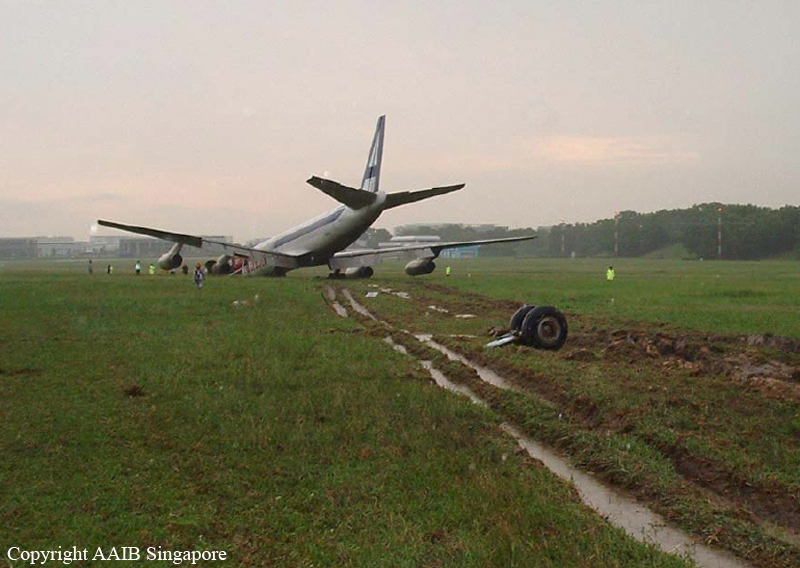

Ground accident of a Douglas DC-8-62F in Singapore
Date & Time:
Feb 28, 2002 at 0044 LT
Registration:
N1808E
Survivors:
Yes
MSN:
46105/494
YOM:
1969
Flight number:
APWP6L
Crew on board:
3
Crew fatalities:
Pax on board:
0
Pax fatalities:
Other fatalities:
Total fatalities:
0
Circumstances:
On 28 February 2002, Arrow Air flight APWP6L touched down on Runway 02L at Singapore Changi Airport at 0029 hours. The weather and visibility conditions were good (visibility in excess of 10 km). Arrow Air flight APWP6L was assigned to park at Bay 117, a remote aircraft parking bay. After APWP6L had landed, the runway controller at Changi Tower instructed the aircraft to taxi towards Bay 117. The aircraft exited the runway via rapid exit Taxiway W4. The ground movement planner at Changi Tower selected the taxiway centre line lights to guide the aircraft from Taxiway W4 onto Taxiway NC1, Taxiway WA and to Bay C7 (Bay 117 is the second parking bay after Bay C7). Due to airside construction works, there was no taxiway centre line lighting guidance on the short segment of taxi route from Taxiway WA from abeam Bay C7 to the adjacent parking Bays 117 and 118. There was a NOTAM in force that stipulated that during hours of darkness, aircraft could only be towed in to Bays 117 and 118. On reaching Bay C7, the flight crew of APWP6L did not stop but continued taxiing past Bay C7 onto a diverted portion of Taxiway WA. The taxiway centre line lights for this diverted portion of Taxiway WA were not switched on by ATC as it was not the intended route for the aircraft. At about 0037 hours, flight APWP6L called Changi Tower to indicate its position near Bay 106. Realising that flight APWP6L had missed its allocated parking position, the ground movement planner at Changi Tower routed the aircraft back to Bay 117 via Taxiways WA, SC, WP, V8 and Taxiway WA. Flight APWP6L followed the return route until it was abeam Bay 117 on the straight section of the diverted portion of Taxiway WA, just before Taxiway VY. At that location, the pilot saw the ground marshaller at Bay 117 on the aircraft’s right side. Instead of continuing to follow the assigned taxi route, the aircraft turned right. In doing so, it left the WA taxiway centre line and went onto a grass area between Taxiway WA and the parking apron. The nose gear of the aircraft went across an open drain of about 1.4 m wide and 0.8 m deep within the grass area. The aircraft came to a halt when its main landing gears went into the drain at about 0044 hours. All three crew members escaped uninjured while the aircraft was damaged beyond repair.
Probable cause:
The following findings were identified:
- The accident took place at night in clear weather.
- The flight crew members were properly licensed, qualified, medically fit, and in compliance with flight and duty time regulations.
- The flight crew had the latest revision of the Jeppesen charts showing the layout of Singapore Changi Airport, including the yellow supplementary chart showing the area near Bay 117 in greater detail.
- The flight crew was not familiar with the Terminal 1 West Apron area where Bay 117 was located.
- The flight crew was aware of the NOTAM tow-in requirement at Bay 117 during hours of darkness.
- The Apron Control duty supervisor was aware of the requirement for aircraft to be towed into Bay 117. He did not coordinate with ATC and the ground handler on towing arrangements as there was no towing procedure established for aircraft assigned to Bay 117 or 118.
- The runway controller was not aware of the requirement for aircraft to be towed into Bay 117. He instructed flight APWP6L to follow the green lights to Bay 117 in accordance with standard ATC procedures.
- The flight crew did not stop at Bay C7 to ask for instructions or guidance to get to Bay 117.
- After missing Bay 117 initially, the flight crew continued taxiing in search of the bay on their own.
- On the subsequent return towards Terminal 1 West Apron, after sighting Bay 117 and the marshaller on the right of the aircraft, the flight crew deviated from the Taxiway WA centre line marking and green centre line lights and turned the aircraft to the right directly towards Bay 117.
- The flight crew did not see a turn signal from the marshaller but believed they saw the marshaller waving a “move ahead” signal.
- The flight crew did not notice on the Jeppesen charts that there was a turf island separating Taxiway WA from the parking apron where Bay 117 was located.
- The flight crew turned right from the straight section of the diverted portion of Taxiway WA to head directly towards Bay 117 even though there was no turn signal from the marshaller, no instruction to turn from ATC and no aircraft parking bay guidance marking on the ground to indicate to the flight crew to turn right.
- The landing lights of the aircraft were turned on.
- As taxiway centre line lights were provided along Taxiway WA, according to ICAO Annex 14, there was no requirement for taxiway edge lights to be provided. However, where there is a large unmarked paved area adjacent to a taxiway, the provision of taxiway edge lights or reflective markers (in addition to taxiway centre line lights) would provide an additional cue to pilots to stay within the taxiway. This may help to prevent pilots inadvertently straying off the taxiway.
- There were no edge lights or markers to show the grass area between Taxiway WA and the parking apron where Bay 117 was located. There is no requirement in ICAO Annex 14 for edge lights or markers to show the presence of grass areas adjacent to taxiways.
- The drain located within the grass area between the diverted portion of Taxiway WA and the parking apron was outside the taxiway strip. According to ICAO Annex 14, drains located outside a taxiway strip are not required to be covered.
- The airworthiness of the aircraft was not a factor in this accident.
- The accident took place at night in clear weather.
- The flight crew members were properly licensed, qualified, medically fit, and in compliance with flight and duty time regulations.
- The flight crew had the latest revision of the Jeppesen charts showing the layout of Singapore Changi Airport, including the yellow supplementary chart showing the area near Bay 117 in greater detail.
- The flight crew was not familiar with the Terminal 1 West Apron area where Bay 117 was located.
- The flight crew was aware of the NOTAM tow-in requirement at Bay 117 during hours of darkness.
- The Apron Control duty supervisor was aware of the requirement for aircraft to be towed into Bay 117. He did not coordinate with ATC and the ground handler on towing arrangements as there was no towing procedure established for aircraft assigned to Bay 117 or 118.
- The runway controller was not aware of the requirement for aircraft to be towed into Bay 117. He instructed flight APWP6L to follow the green lights to Bay 117 in accordance with standard ATC procedures.
- The flight crew did not stop at Bay C7 to ask for instructions or guidance to get to Bay 117.
- After missing Bay 117 initially, the flight crew continued taxiing in search of the bay on their own.
- On the subsequent return towards Terminal 1 West Apron, after sighting Bay 117 and the marshaller on the right of the aircraft, the flight crew deviated from the Taxiway WA centre line marking and green centre line lights and turned the aircraft to the right directly towards Bay 117.
- The flight crew did not see a turn signal from the marshaller but believed they saw the marshaller waving a “move ahead” signal.
- The flight crew did not notice on the Jeppesen charts that there was a turf island separating Taxiway WA from the parking apron where Bay 117 was located.
- The flight crew turned right from the straight section of the diverted portion of Taxiway WA to head directly towards Bay 117 even though there was no turn signal from the marshaller, no instruction to turn from ATC and no aircraft parking bay guidance marking on the ground to indicate to the flight crew to turn right.
- The landing lights of the aircraft were turned on.
- As taxiway centre line lights were provided along Taxiway WA, according to ICAO Annex 14, there was no requirement for taxiway edge lights to be provided. However, where there is a large unmarked paved area adjacent to a taxiway, the provision of taxiway edge lights or reflective markers (in addition to taxiway centre line lights) would provide an additional cue to pilots to stay within the taxiway. This may help to prevent pilots inadvertently straying off the taxiway.
- There were no edge lights or markers to show the grass area between Taxiway WA and the parking apron where Bay 117 was located. There is no requirement in ICAO Annex 14 for edge lights or markers to show the presence of grass areas adjacent to taxiways.
- The drain located within the grass area between the diverted portion of Taxiway WA and the parking apron was outside the taxiway strip. According to ICAO Annex 14, drains located outside a taxiway strip are not required to be covered.
- The airworthiness of the aircraft was not a factor in this accident.
Final Report:
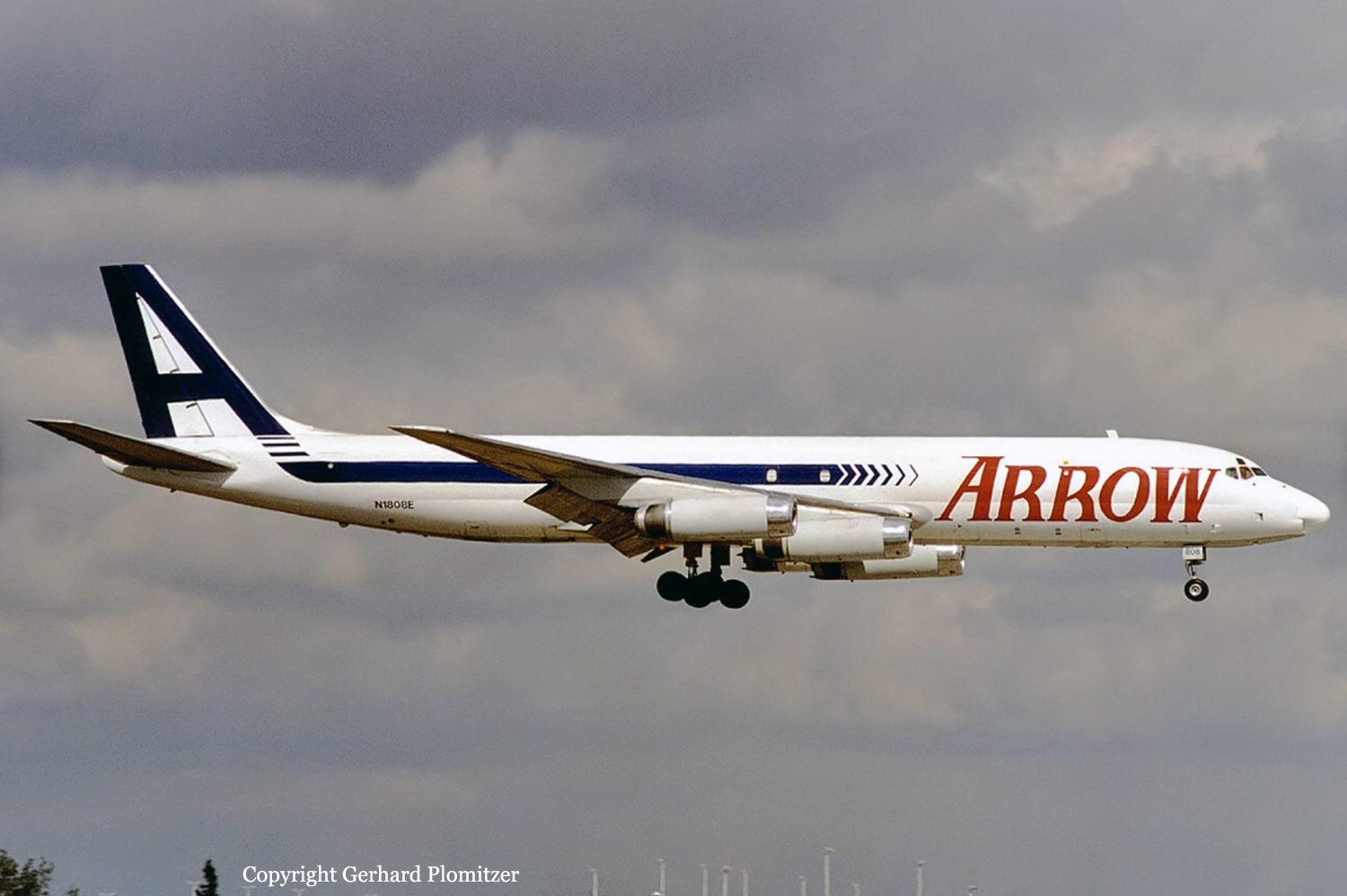
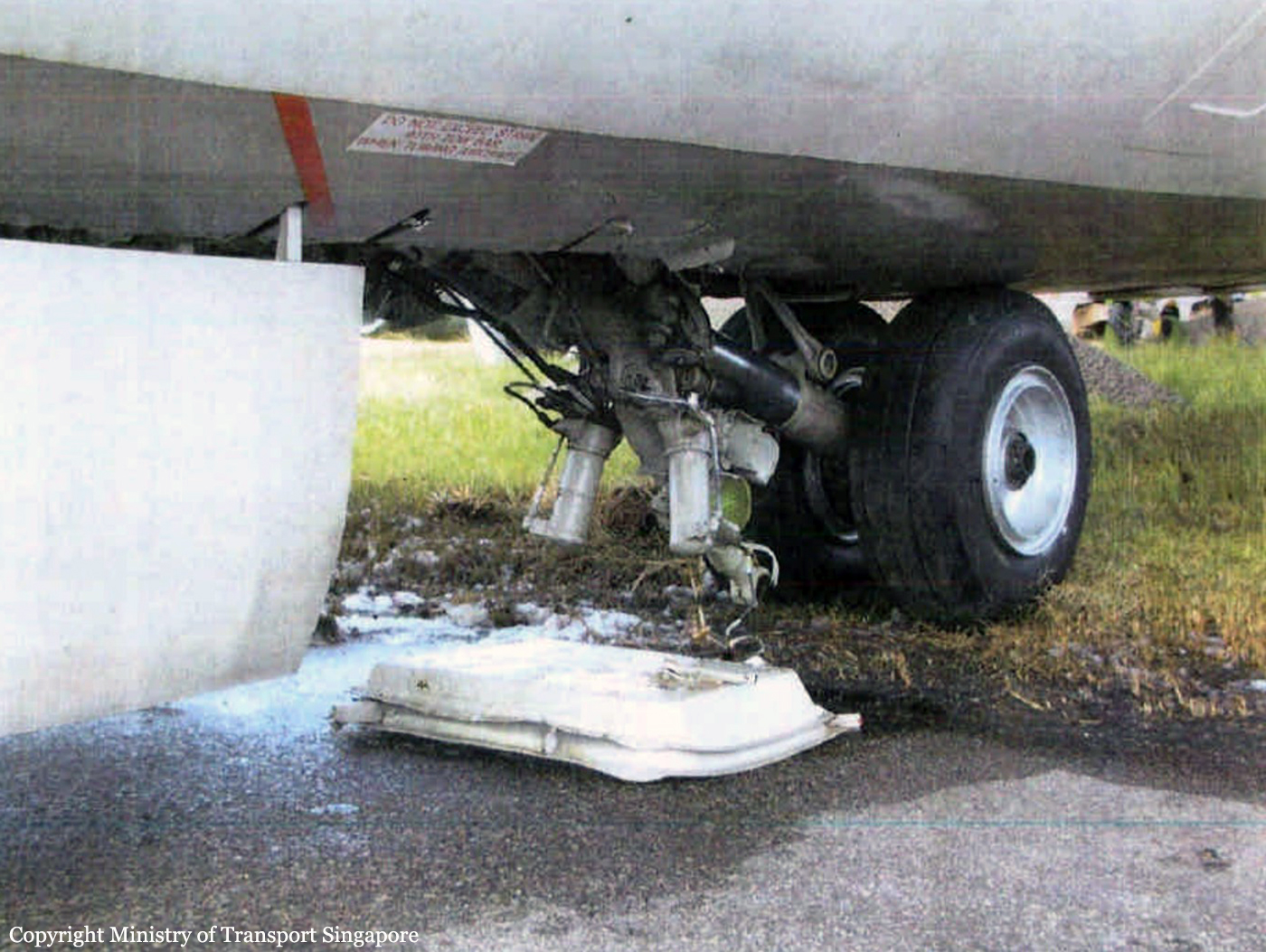

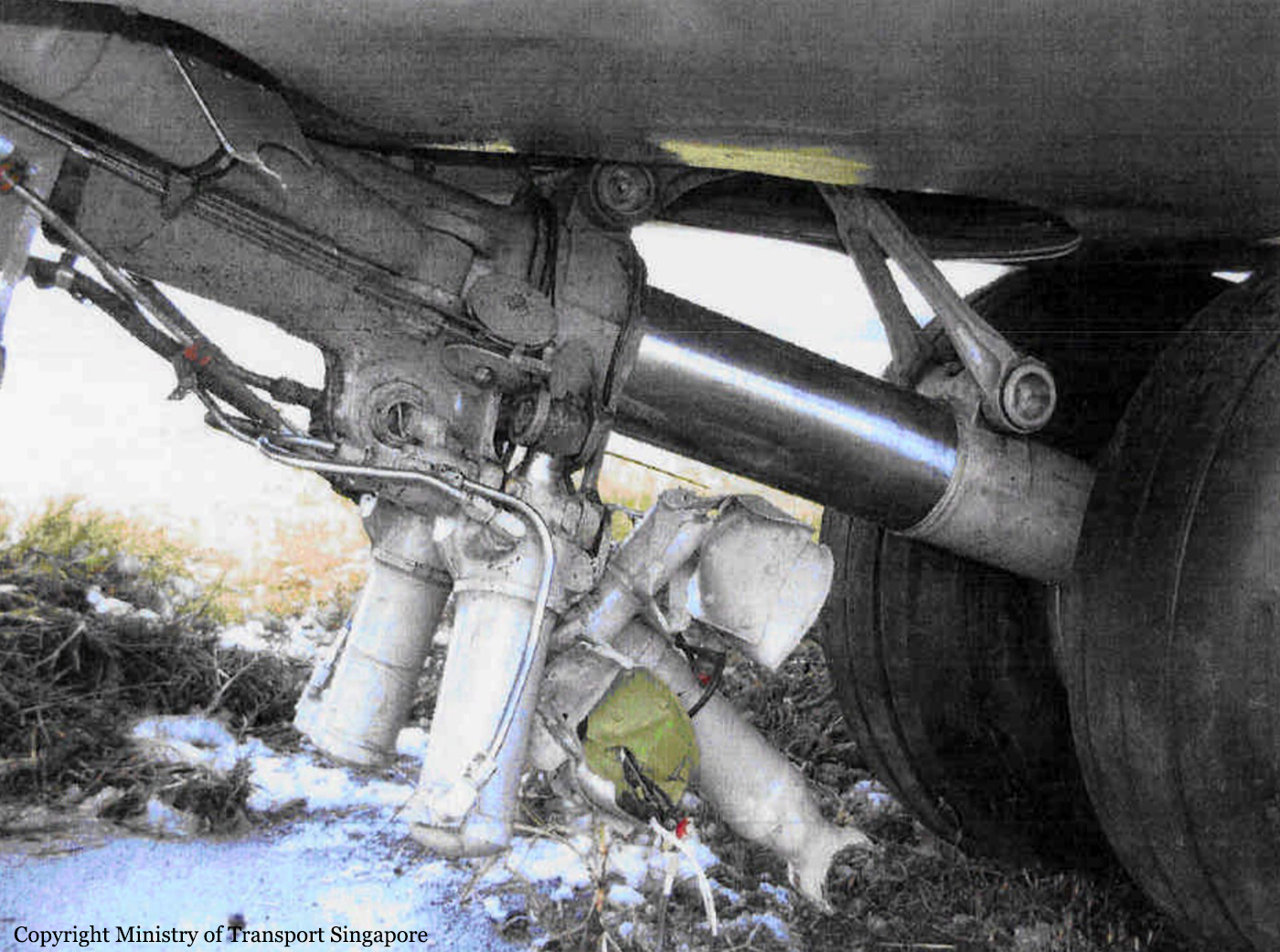
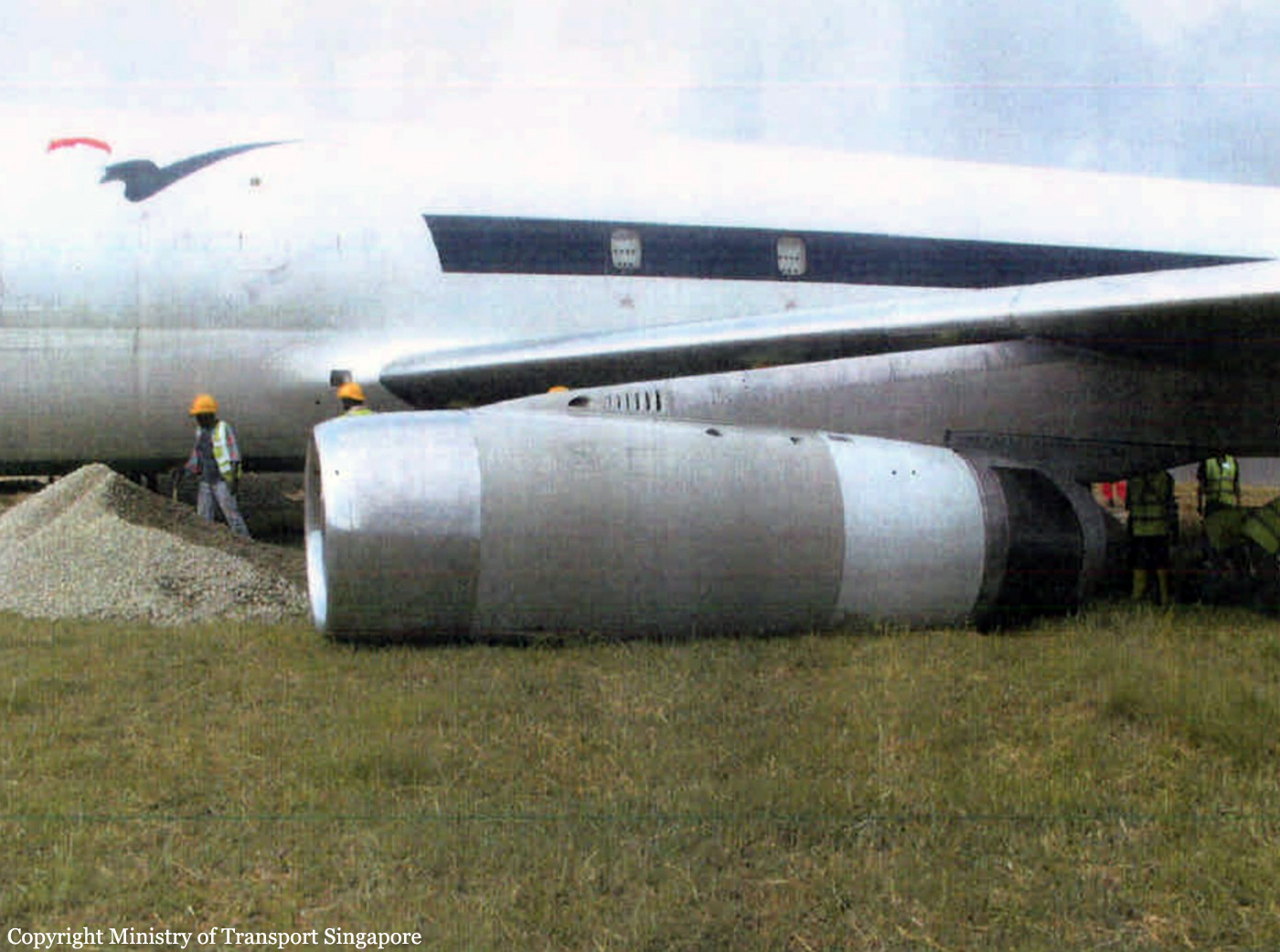
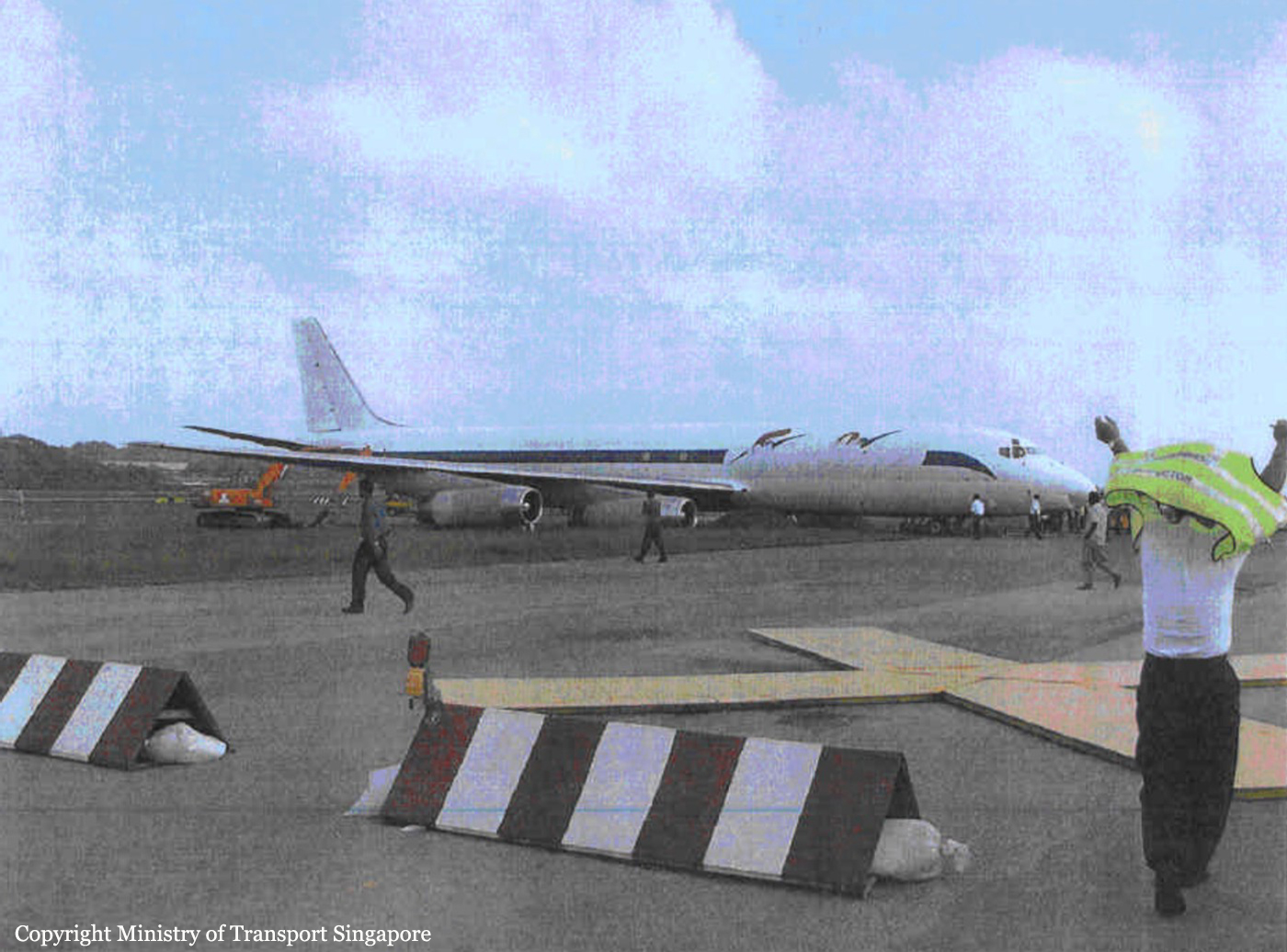
Crash of a Fokker F28 Friendship 4000 in Singapore
Date & Time:
May 16, 1998 at 1315 LT
Registration:
PK-VFY
Survivors:
Yes
Schedule:
Jakarta - Singapore
MSN:
11179
YOM:
1982
Crew on board:
7
Crew fatalities:
Pax on board:
73
Pax fatalities:
Other fatalities:
Total fatalities:
0
Circumstances:
The aircraft departed Jakarta-Halim Perdanakusuma Airport on a charter flight to Singapore, carrying expatriates who were leaving Indonesia due to political unrest. On approach to Singapore-Seletar Airport, the copilot followed the checklist but failed to arm the lift dumper which affected the antiskid system that could not be used. After landing on a wet runway surface, the crew started the braking procedure but this was insufficient so the captain applied emergency brakes which is not recommended when hydroplaning is suspected. Unable to stop within the remaining distance, the aircraft overran, lost its left wing and left main gear before coming to rest. All 80 occupants escaped uninjured while the aircraft was written off.

